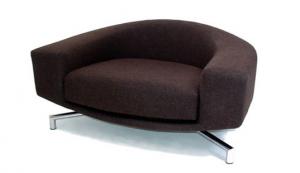- 22 reads

Question: I am looking for a reupholsterer who uses green products and processes, but no one that I've called has any idea what I'm talking about. Can you offer advice for reupholstering furniture in an environmentally sustainable way? And where I can find nontoxic "stuffing"?
Answer: First of all, reupholstering an existing frame is a very green thing to do. It's also a great way to get a custom look.
Buying used furniture
Used furniture in classic and mid-century styles can be found inexpensively at thrift stores and estate sales—especially when worn, torn, or stained upholstery is not a concern.
- Remember, what you are looking for is the right silhouette.
- Older frames for chairs and sofas are often very well built, sometimes better than new frames.
- When buying a vintage upholstered piece I always give it a heft to see if it's heavy: hardwoods are heavier than softwoods. Then I give the piece of furniture a shake to see that the joints are firm and the frame won't torque.
Working with an upholsterer
Don't worry if the upholsterers you speak with have no idea what you are trying to do. Any upholsterer can do green work if you give them clear instructions. I would choose an upholsterer whose work you have seen and liked, and who at least seems interested in working with you on a green project.
Here's some basic information to help you guide your reupholsterer.
- A chair or sofa is made up of a frame, springs and/or webbing, a bouncy layer or cushion, a soft layer or padding, and then the fabric.
- In a vintage piece, the frame should be strong, and any good upholsterer should be able to rebuild the springs in the platform (the area under the cushions).
- The cushions have a springy or bouncy center usually made of foam, or a spring unit wrapped in foam. In green upholstery, it is important that this foam is not treated with a brominated fire retardant. (PDBEs are one example you might have heard of. These harmful chemicals are bioaccumulative and have been found in the cells of most people in the United States, including in human breast milk.)
- I use natural latex foam, which can be ordered online at FoamOrder.com in custom shapes and sizes.
Wrapping the foam to retard flame
Latex foam is not naturally fireproof, so the foam cushion must be wrapped in something that will retard flame.
- In less expensive green upholstery this is achieved by using a fireproof ticking.
- In high-end pieces, natural wool batting is used as the soft cushion wrap.
This wool creates a nontoxic, breathable layer, but should be covered by a down-proof ticking. (In the first few green reupholstery jobs I worked on, I did not do this, and I am beginning to see a few wool hairs sticking out through the fabric. Luckily, I experimented in my own home before using these techniques with clients!) The tightly woven ticking layer has another benefit if people in your household have allergies: it helps keep dust and dust mites from penetrating into the cushion.
Selecting fabric
When you're selecting fabric, the visual qualities are usually the prime consideration. Fortunately, there is a broad selection of natural and nontoxic fabrics available.
- Q Collection is a great overall source;
- Oliveira Textiles, Harmony Art and Mod Green Pod have fun prints; and
- Solid hemp woven fabrics are available from Enviro Textiles and Pickering Hemp.
Many of the companies making fabric for commercial furniture have done a great job of coming up with fabrics that use nontoxic and heavy-metal-free dyes, recycled fibers, and natural fibers. The Climatex Lifecycle line and the Maharam Reduced Environmental Impact line both have some good choices.
If you fall in love with a fabric and are uncertain whether there are harmful finishing chemicals on it, you can buy a sample yard and try washing it. Washing will get rid of many treatments commonly used on fabric, but it might affect color, stain resistance, or length of your yardage.
Have fun with your project
So to review, you should tell your upholsterer you want to:
- use the frame you already own,
- retie or replace the springs,
- then use natural latex as foam, and
- wool batting instead of polyester batting.
The cushions should have a tightly woven ticking under the upholstery fabric, and the fabric itself should be natural and nontoxic.
Have fun with your project—you will be doing the world a service if you can teach one more professional how to do a green reupholstery job.
This article How can I reupholster furniture sustainably? originally appeared in the USGBC's Green Home Guide - an excellent source for green home expertise, ideas, and connections.
Kirsten Flynn, is the principal designer at Sustainable Home, a service design firm that works primarily with residential projects.

